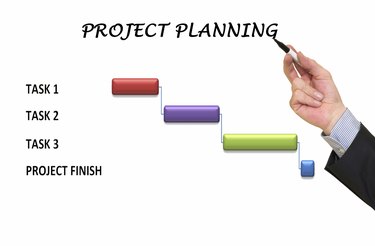
If you're about to launch a new product, service, system or process, you must decide how to roll it out. In some cases, it makes sense to go for a full rollout, making an immediate company-wide change. In others, it may be better to use a staggered rollout, using a staged release process. This approach has some advantages. For example, it may reduce risk and minimize negative effects on productivity. It also gives you time to make improvements and to engage stakeholders to get them on board with the change.
Minimized Risk
Video of the Day
A staggered rollout reduces risk, allowing you to test change before you move onto full implementation. For example, if a retail company wants to open stores in a foreign country, it will reduce risk by trialing one store in one location first, even if its long-term plan is a country-wide network of stores. It can then evaluate market viability and make an informed decision on how or whether to move onto a full rollout.
Video of the Day
Ongoing Modification and Improvement
A staggered rollout allows you to trial change in discrete business areas. You can test how it works, gather stakeholder opinions and make improvements as you go along. For example, if a company is rolling out a new software system, it could stage implementation by department. Bugs and user-interface issues can be fixed during any stage without time pressures. By the time the system reaches full implementation, it should be user-friendly, bug-free and operationally-effective.
Positive Effects on Productivity
Rolling out a new internal system or process may affect your productivity. If you stagger the rollout, you can restrict this to one area of your business at a time. For example, if you want to implement a new financial reporting process, you can roll it out to one office first. During the rollout, the affected group may not be as productive as usual, and their performance may dip while they receive training and get used to the switch. Typically, it's business as usual for your other offices. In a full rollout, all of your employees switch to the new system at the same time, potentially affecting productivity on a company-wide basis.
Better Stakeholder Engagement
A staggered rollout plan gives stakeholders more time to come to terms with the change and to accept it. This is especially useful with employees who may be resistant to change. If they can see that the new rollout works for other employees in each stage, they'll be more positive about it. If the new system or process works well or is modified to fix problems during rollout stages, employees who use it will be more enthusiastic about it. This enthusiasm builds confidence in groups who'll go through the rollout later.
- EHR Intelligence: EHR Best Practices -- Choosing an EHR Rollout Strategy
- Software Advice: ERP Implementation Strategies – A Guide to ERP Implementation Methodology
- Toolbox.com: Big Bang Vs. Phased Rollout -- Which ERP Implementation Strategy Is Best?
- The Business of Fashion: Whistles Continues Global Expansion with Department Store Strategy